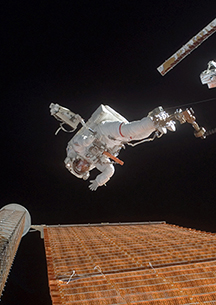A Sandia team of engineers was instrumental in the success of the most recent space shuttle mission. Sandia has played an important role in every shuttle flight since the return-to-flight mission following the Columbia accident.

The joint Sandia/NASA Laser Dynamic Range Imager Orbiter Inspection System (LOIS) team successfully completed all Orbiter Boom Sensor System (OBSS) inspection activities on NASA space shuttle mission STS-120 last month.
STS-120 was the 23rd shuttle mission to the International Space Station (ISS). The mission delivered the Harmony node to the space station and made a critical repair to the torn P6-truss solar panel.
Bob Habbit (5718) says the mission marked many firsts for the joint Sandia/NASA team. These included the inaugural flight of LDRI Flight Unit 3, the first operational use of the new data processing software/hardware suite, and transfer of the bulk of the data processing workload to local NASA operators.
The tear in the P6 solar panel of the space station resulted in another first, says Bob. OBSS was developed post-Columbia to enable on-orbit inspection of the shuttle’s thermal protection systems (TPS). The OBSS in conjunction with the ISS robotic manipulator enabled the astronauts to implement the repair of the P6 solar panel.
The successful operation of Flight Unit 3 after its exposure to unusual temperature extremes during this unplanned use of OBSS made it possible for a nominal pre-reentry inspection of the orbiter’s TPS, assuring the safe return of the crew and Discovery.
“The tear had to be fixed in order to complete the extension of the solar array,” Bob says. “The repair was a high priority.”
Failure of the repair attempt would have required jettisoning the P6-truss assembly. This unplanned repair required around-the-clock mission planning and analysis by NASA Engineering with support from the Sandia engineering team.
“Several NASA senior staff remarked that this effort was akin to Apollo 13,” says Bob. “While the crew was not in immediate jeopardy, implementing the repair required the crew to operate in a very hazardous environment.”
Sandia will continue to maintain ownership for operational execution and supply onsite expert support in Mission Control Center in Houston through the life of the Shuttle program.
Mission execution requires 24/7 support, and the Sandia team adjusts their schedules to meet the needs of the NASA and the astronauts, Bob says.
“When situations arise the team works around the clock until the problem is solved,” he says. “This project execution would not be possible without extensive
teaming across the Laboratories. I have been particularly impressed and proud of how Sandia mobilizes to meet national needs.
“The Sandia LOIS development team greatly exceeded our sponsors’ expectations. All team members took personal responsibility and ownership for the deliverables, working many extra hours on their own accord.”
Sandia’s Laser Dynamic Range Imager Orbiter Inspection System team
John Sandusky (5718, project manager), Dennis Clingan (2618), Larry Dalton (2622), Erik Fosshage (12343), Steve Gradoville (2661), Simon Hathaway (2623), Brenna Hautzenroeder (2623), Bob Habbit (5718), Mark Heying (2664), David Karelitz (9326), Bob Nellums (5718), Eric Ollila (2623) Dave Peercy (12341), Todd Pitts (5718), Gus Rodriguez (5715), Jose Rodriguez (2664), Megan Resor (2622), and Daniel Talbert (5718).